Light Drawing
Header Image: Least Bittern
Clear skies and the wind had subsided. Two hours before sunset. I had a sudden notion to wander along the western shore of the lake where the sinking sun would provide strong but warm light as I peered into the reeds and trees lining this side of the lake. I knew there were breeding egrets and herons here, but would their nests be visible?
When attempting to learn about photography (a work STILL in progress), we’re told how important light is in making a pleasing image. Indeed, the very word “photography” is formed from two Greek words for “light” and “drawing”. We are further instructed that, in nature photography, the very best light is available a couple of hours around sunrise and sunset. The “Golden Hours“. Some very intent students take that a bit to the extreme and almost refuse to carry a camera outside those parameters. Fortunately, I’ve never been a very good student.
On this day, however, I actually saw the words “Golden Hours” illuminated within my brain and that motivated me to go forth and shoot birds. I even took a tripod. And used it. On purpose. No, really.
A two-mile meander (I don’t think bird photographers actually “walk” and we most certainly don’t “hike”) along the edge of the lake was not only pleasant, it turned out to be what, in another lifetime, I recall Air Force combat jet pilots referring to as a “target-rich environment“. Birds were busily preparing for a night of roosting by very actively hunting for a last-minute meal.
A pair of Black-bellied Whistling-Ducks prepare for a quiet evening by preening and taking care of an itch.

The best roosting logs are occupied early or else a young Limpkin might have to sleep in the reeds or in a tree.

This particularly tall cypress tree is serving as an Anhinga nursery. These water birds tend to nest in colonies and I counted eight nests in this one tree. Immature birds, seen here, retain an overall whitish plumage for about the first three weeks after hatching, at which time the feathers turn light brown as they prepare to fledge.

Let’s just check out this dock which offers a good view into the reeds. Hmmm. It seems other nature lovers are already here. We wouldn’t want to disturb them so let’s just see what’s on down the shore line. (Those are empty apple snail shells on the dock left by Limpkins and/or Snail Kites.)

The chamber of commerce has hired a few event actors to pose for eco-tourists such as yours truly. A Glossy Ibis shows off an impressive wingspan and then folds the wings neatly to exhibit the “mother-of-pearl” iridescence which is its namesake.
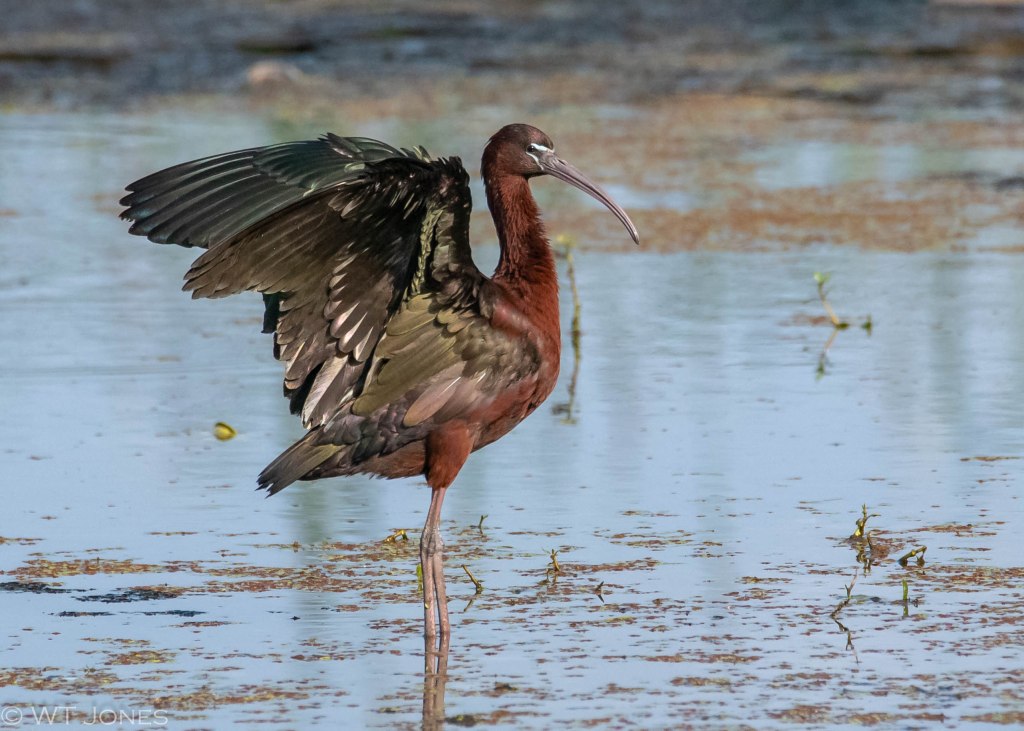
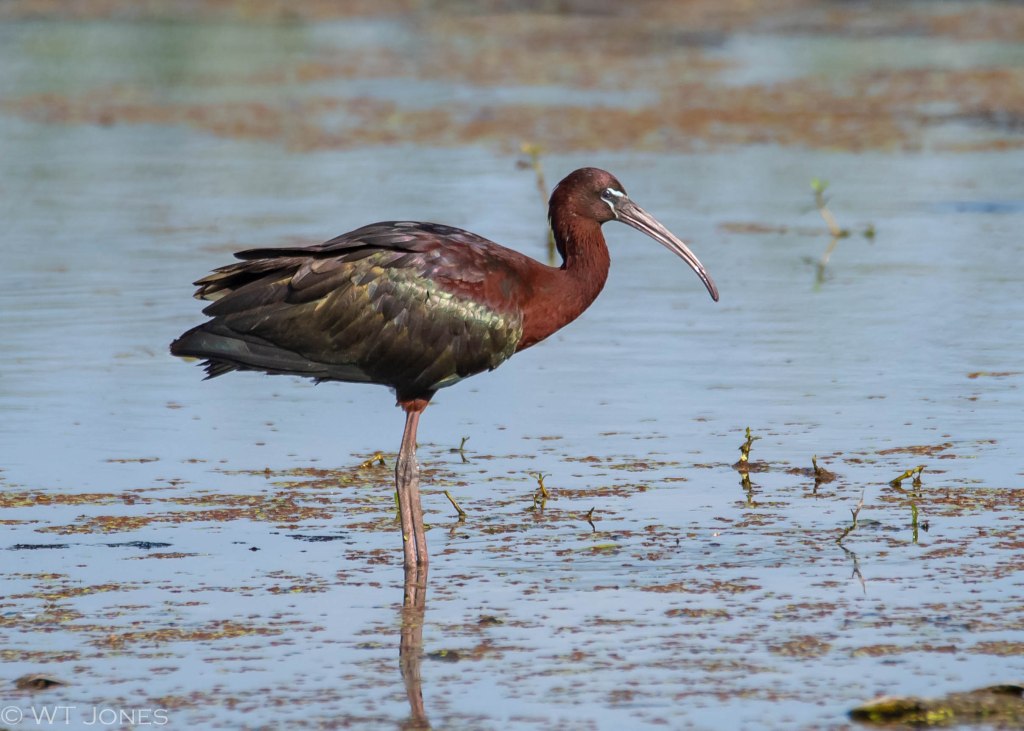
Once upon a time, we had friends over for barbecue. One of the visitors stated he didn’t care for BBQ, not because of the taste, but because he couldn’t eat it without getting messy. Gini, always the helpful hostess, advised: “If you don’t get it all over yourself, you’re not eating it properly.” (She then pointed the picky diner to the cabinet holding the peanut butter.) This adult White Ibis would have felt right at home at our BBQ table, based on the amount of mud on its bill. Breeding season has turned the bird’s bill and legs a brighter shade of red than normal.

Immature White Ibises are brown, white feathers begin to appear during their first summer, they show more white during the winter and by their second summer they will achieve full adult plumage. The bird in this image is likely about a year old and will be all white by summer’s end.
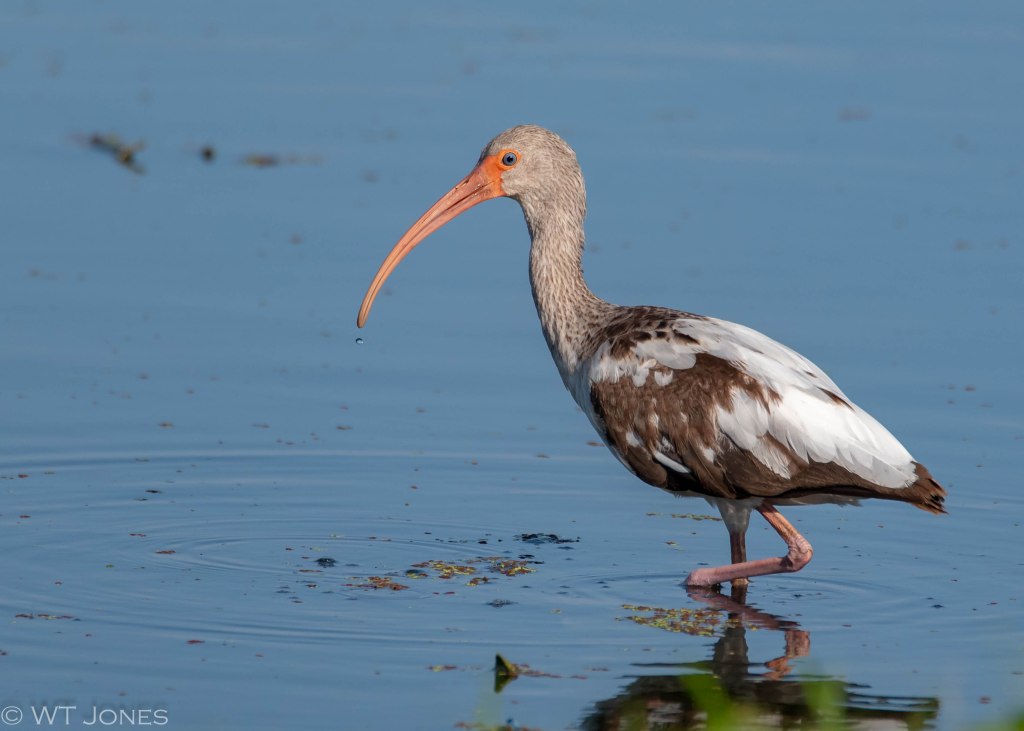
Stealth is the means by which many birds survive. Watching this Tricolored Heron move in on its prey was like watching the hands of a clock. I knew he was moving, but couldn’t see it happening. Note the white head plume, only present during breeding season.

At the end of the day, a Great Blue Heron hopes for just one more frog. Don’t we all?

Somewhat surprising was finding a very busy Spotted Sandpiper. They breed in our area but I haven’t seen many around this lake. Nice to see one with all its spots, as opposed to the plain winter plumage.

Several years ago, the city erected a Purple Martin house by the lake. It has enjoyed full occupancy every year since. Indulge me for a little while as it is supper time.
Adult male Purple Martin. We typically see them flying at high speed and they appear black. Good light reveals how they got the name.

Mom brings a Four-spotted Pennant (Brachymesia gravida) to a hungry chick.
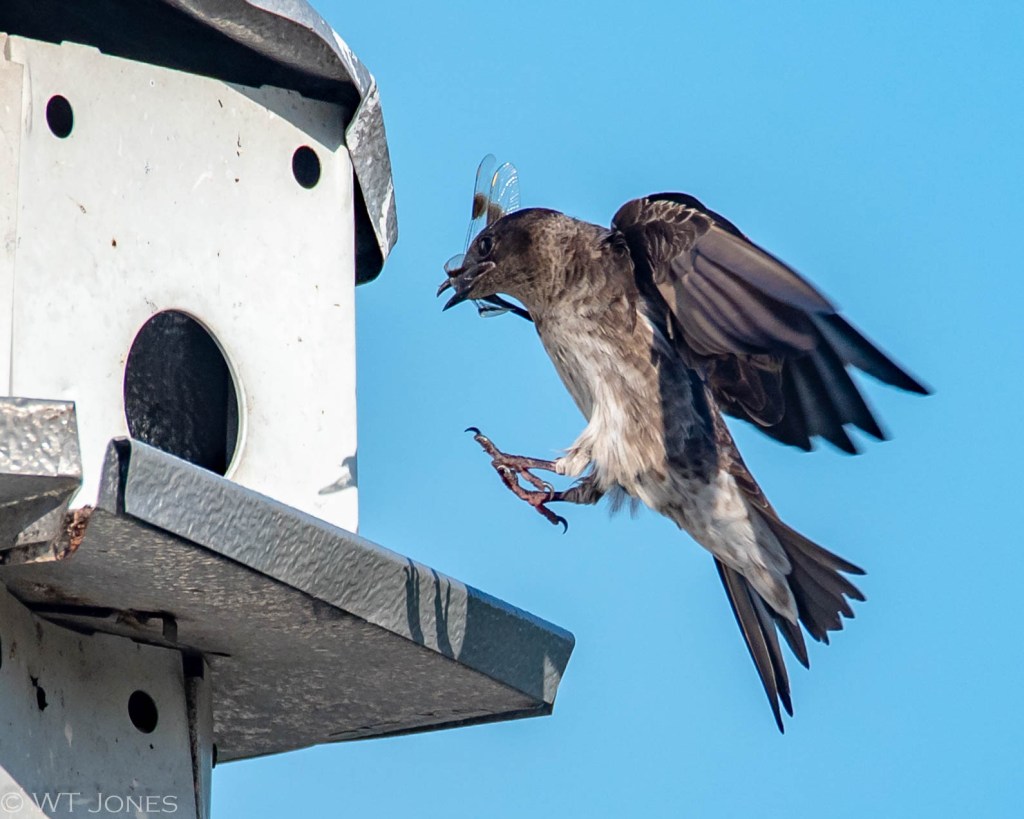
Junior receives a regal repast of Prince Baskettail (Epitheca princeps) as Dad watches to be sure the kid doesn’t choke.

The diligent parent cleans up after junior’s meal by removing the fecal sac from the nest. (Many bird species nestlings produce a mucous sac to contain feces which is removed by a parent to keep the nest clean.)
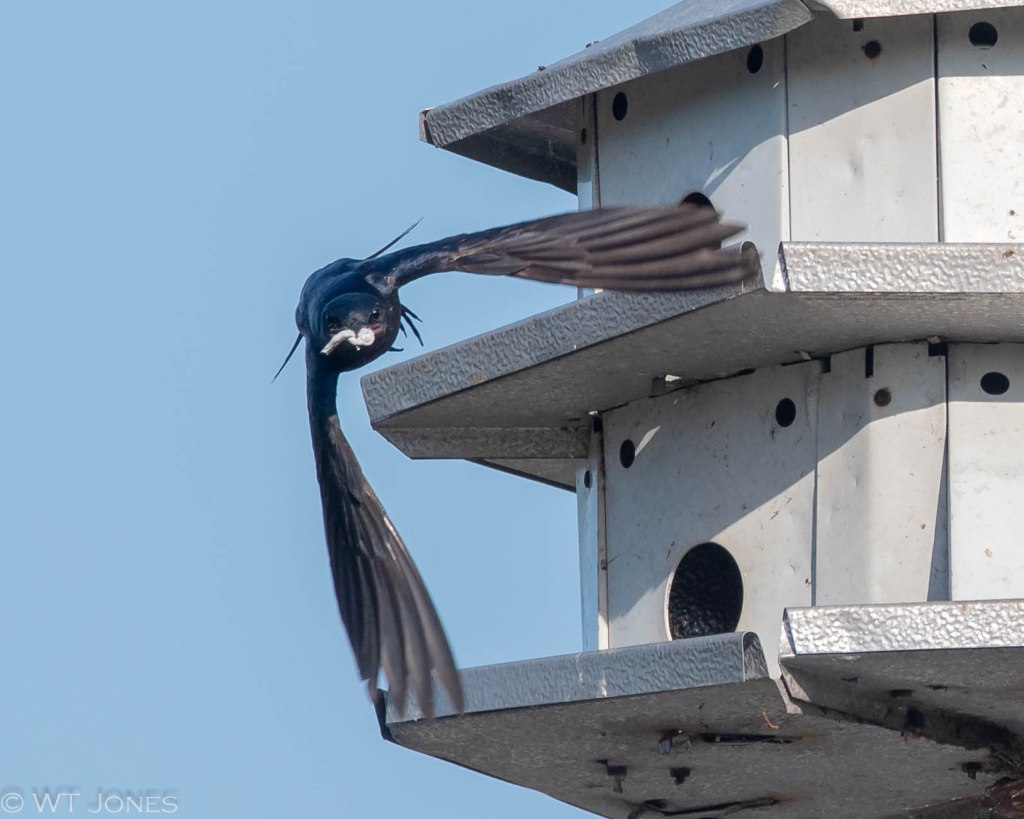
Another female brings a last-minute dragon as it will soon be dark and time for young Martins (as well as Mom and Dad) to rest.

During breeding season, the bill turns blue and the eyes of the Little Blue Heron turn quite dark. There were heron and egret nests in these reeds but they were not visible from the shore.

A male Snail Kite conducts one last sortie for some escargot to go with his lemon garlic butter.
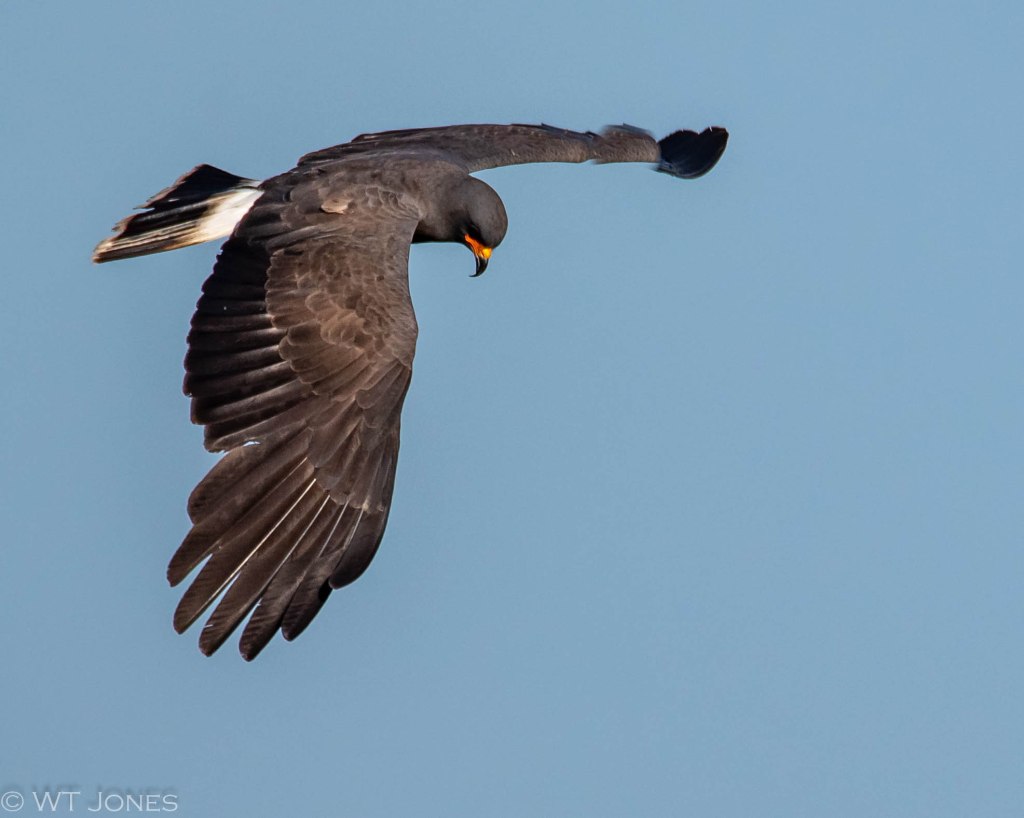

Sunset. A Least Bittern tried her best to become a tall reed. I pretended not to see her, but I’m pretty sure she could hear all that “click-click-clickety” going on. It was a great way to end a day.

Although I covered a couple of miles, I can’t really say I benefited from very much “exercise”. Walk three steps, take pictures, walk two steps, take pictures, etc. There was a lot of bird activity at the close of the day and the “golden hours” lived up to their billing. The light was perfect, the drawing was enjoyable.
Enjoy your search for a natural place and come back for a visit!
Just a very quick note, Wally, to say how much I enjoyed this post. Just back from the Outer Hebrides and, sadly, Lindsay started Covid symptoms on Sunday and has now tested positive and is feeling quite rough, so I’m somewhat distracted. Best wishes to you and Gini – – – Richard
LikeLike
Take care of Lindsay, Richard.
We’ll be here when all is well again.
Our thoughts are with you both.
LikeLike
Great shots of birds I don’t see and birds that I do see. Great shots. At first glance I thought the young alligator was a dock ornament and not real.
Yes, photography is a learning experience. Lifelong just as is life itself.. Pablo Casals on why he continued to practice in his advanced years….” “Because I think I am making progress.” ” Ansel Adams continued to improve upon his darkroom printing even redoing his masterpieces.
All light is good light. Some is just more challenging than others.
LikeLike
I really appreciate your comments and insight, Steve.
Yep, sometimes (most of the time?) we don’t get a choice in having great light but must make do with what nature give us.
Have a good weekend.
LikeLiked by 1 person
Wally that was well worth getting out there near the end of the day and with such wonderful lighting, your photographs are super. The series of shots of the Purple Martin are brilliant. Those bugs are so large for the chicks but i am sure the parents know best. I have been extremely busy with helping my daughter after her terrible car accident and then the Ukrainian lady Valentia arrived as they are hosting her and she could not speak 1 word of English so my teaching skills have once again come to the forefront but she is lovely and a joy to be with and help her settle in. She is fortunately a quick learner and getting on well now after only a few days on the Isle of Wight but a long way to go. Early days but it is now looking more positive for her as she is from Odessa in Ukraine. I am sending my good wishes to Gini and yourself and hope to have a great weekend and more wonderful adventures next week.
LikeLike
Thank you so much for the kind comments, Margaret!
Gini and I are well and we are praying for you and your daughter. And for the guest from Odessa!
LikeLike
A great walk shared, Wally. I love the stance of that bittern, braced against the outward-leaning reeds. I’ve seen red-winged blackbirds do that as well, even to the point where their feet are much further apart than their shoulders!
LikeLike
Thank you, Sam.
The birds who live among the reeds offer us an entertaining display at times!
LikeLike
Beautiful light drawing, and I really enjoyed the post. I had to laugh about the slow pace of your two miles. I’m not a birder, but my hiking pace is similar. Walk a little, stop and take a photo, repeat over and over. It’s an even slower pace during the golden hour!
LikeLike
Hi, Peter! Thank you for such nice comments. We really appreciate your visit.
Truth be told, lately, my pace is pretty much the same no matter what I’m doing!
S-L-O-W.
LikeLike
That is a target rich environment! I like all of your photos Wally, but the Spotted Sandpiper and the Purple Martin sequence are standouts for me. Thanks for sharing!
LikeLike
I appreciate it, Ed.
Evenings like that are what keeps us going outside carrying a bunch of gear.
LikeLike
Speaking of alligators, I thought at first that was a snake in the lower right of that photo. Then I decided it was a small alligator. It’s photograph as Rorschach! I’ve always had trouble separate the White-Faced Ibis from the Glossy. I’ve always thought I was seeing the Glossy, but I’m going to have to study my photos a bit more. I may have been seeing White-Faced Ibis in non-breeding plumage. In any event, they’re among my favorites, because of that iridescence.
I smiled at your use of ‘meander.’ That’s it, exactly. If I want to hike, or even walk briskly, for that matter, I make sure to leave the camera at home.
LikeLike
**’separating the White-Faced Ibis from the Glossy’
LikeLike
I’m still not sure if that little ‘gator was an offspring of the larger one or if it might be a snack. They are not hesitant about eating one of their own species.
The Glossy and White-faced Ibis can be tough to separate sometimes. Usually, the White-faced will have the white facial border going all the way around the eye whereas the Glossy does not. Also, the White-faced may have a reddish eye versus the brown of the Glossy. Immature birds are very tough to tell apart, especially at any distance. The White-faced Ibis is much more common in your Texas coastal area than the Glossy.
Yeah, meander. Pretty much describes my pace at doing anything.
LikeLiked by 1 person
I just enjoyed a multi-course meal of pure beauty and remarkableness (probably not a word, but should be). Iridescence! Whoa. Golden Hours indeed, WT. Your joy is contagious.
LikeLike
Happy you enjoyed it, Sister!
On this blog, any word you care to use is valid.
Love you!
LikeLike
The Bittern is such a neat sighting! We haven’t seen one at all this year and thought we had missed out. Maybe there’s still hope. Love the photo of the baby bird with it’s mouth open! Doesn’t it know to chew it’s food! lol Oh and we hiked yesterday….I know because I only took 9 photos! When we’re at a good birding place, we don’t cover much ground and take more than 9 ! lol It’s HOT but I hope we can get out tomorrow morning! Enjoy your week!
LikeLike
Thank you, Diane.
Yep, it’s late spring in Florida, when heat and humidity compete for the highest number!
LikeLike
The Purple Martin sequence is stunning! Feeding those chicks dragonflies, I couldn’t believe my eyes, that’s one big meal.
Fantastic pictures all round for a mere 2 hour stroll.
LikeLike
Thanks, Brian.
I’ll be doing that again. Soon!
LikeLike
Thank you for sharing your golden hours–and golden encounters. I absolutely HAVE to visit Florida–there were 8 life birds for me in this outing alone! I wonder if I could report them on e-Bird. 😊
LikeLike
You’re very kind, Tanja.
Just a note from someone who has tried. E-Bird will not accept “American Alligator” as a valid bird species.
LikeLiked by 1 person